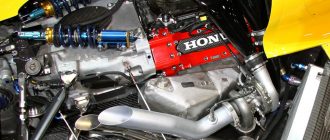What is the Engine Management System in a Car?
The engine management system (EMS) is a computerized system that controls the engine’s operation. It is responsible for managing the fuel injection, ignition timing, and other engine functions to optimize performance and efficiency.
The EMS consists of a number of components, including:
* **Electronic control unit (ECU)**: The ECU is the brain of the EMS. It receives input from various sensors and controls the engine’s operation based on this input.
* **Sensors**: The EMS uses a variety of sensors to monitor the engine’s operation. These sensors include:
* **Oxygen sensor**: Measures the amount of oxygen in the exhaust gases to help the ECU adjust the fuel injection.
* **Coolant temperature sensor**: Measures the temperature of the engine coolant to help the ECU adjust the ignition timing.
* **Intake air temperature sensor**: Measures the temperature of the air entering the engine to help the ECU adjust the fuel injection.
* **Actuators**: The EMS uses actuators to control the engine’s operation. These actuators include:
* **Fuel injectors**: Inject fuel into the engine’s cylinders.
* **Ignition coils**: Provide the spark to ignite the fuel in the cylinders.
* **Variable valve timing (VVT)**: Adjusts the timing of the engine’s valves to improve performance and efficiency.
The EMS is a complex system that plays a vital role in the operation of a car’s engine. It is responsible for managing the fuel injection, ignition timing, and other engine functions to optimize performance and efficiency.
How does the EMS work?
The EMS works by receiving input from various sensors and then using this input to control the engine’s operation. The ECU is the brain of the EMS and it is responsible for interpreting the sensor input and sending the appropriate commands to the actuators.
The EMS uses a variety of control algorithms to optimize the engine’s operation. These algorithms take into account factors such as the engine speed, load, and temperature. The EMS also uses adaptive learning to adjust its control algorithms over time based on the engine’s operating conditions.
What are the benefits of the EMS?
The EMS provides a number of benefits, including:
* **Improved performance**: The EMS can help to improve the performance of the engine by optimizing the fuel injection, ignition timing, and other engine functions. This can lead to increased power, torque, and fuel efficiency.
* **Reduced emissions**: The EMS can help to reduce emissions by optimizing the engine’s operation. This can help to reduce the amount of pollutants released into the environment.
* **Improved reliability**: The EMS can help to improve the reliability of the engine by monitoring its operation and protecting it from damage. This can help to reduce the number of breakdowns and repairs.
Conclusion
The engine management system is a vital part of a car’s engine. It is responsible for managing the fuel injection, ignition timing, and other engine functions to optimize performance and efficiency. The EMS is a complex system that uses a variety of sensors, actuators, and control algorithms to achieve its goals.




